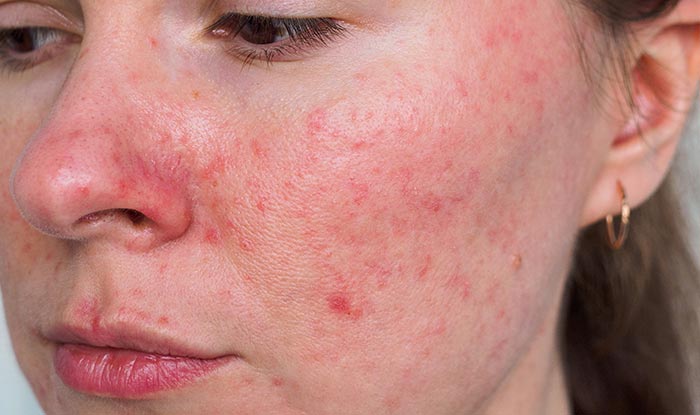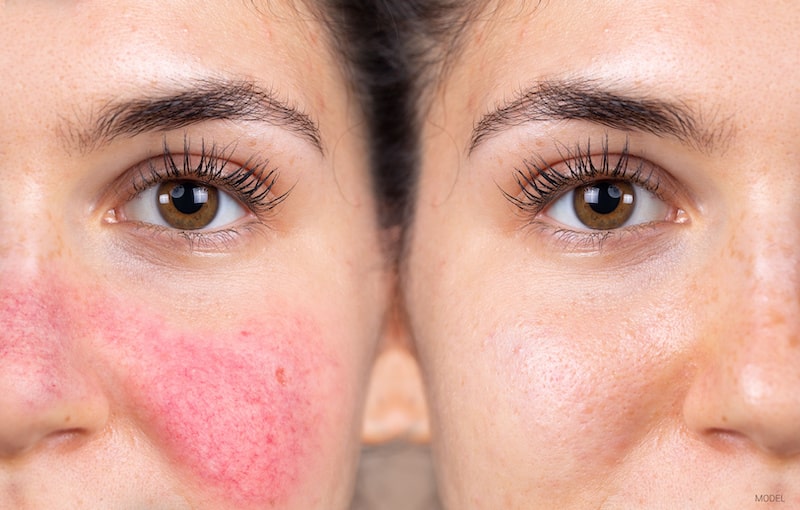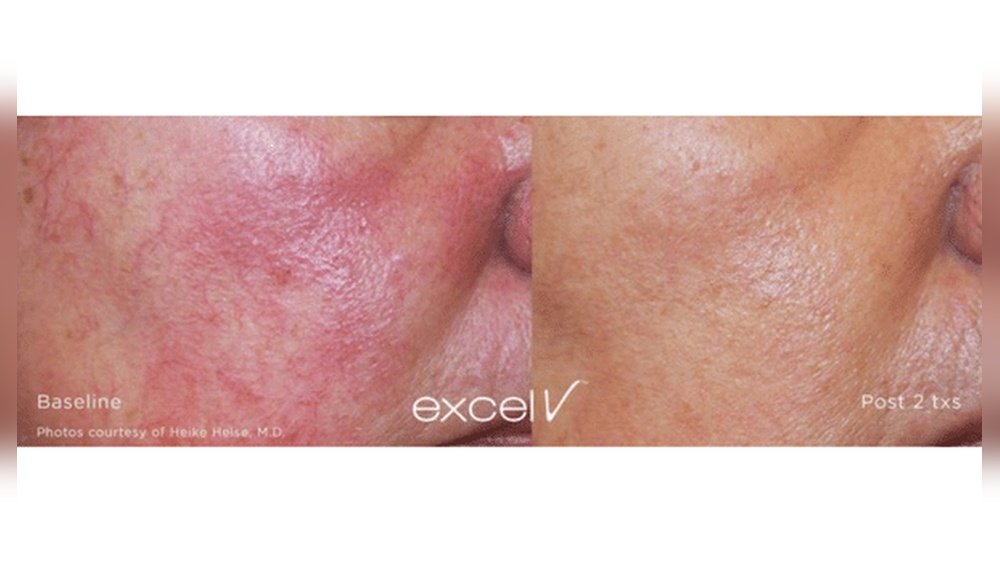Are you tired of dealing with those stubborn red patches that flare up on your face, making you feel self-conscious and uncomfortable? Inflamed, irritated skin can disrupt your confidence and daily routine, but the good news is—you don’t have to suffer in silence.
Understanding how to calm these red, inflamed patches quickly and effectively can make a huge difference in how your skin looks and feels. You’ll discover simple, proven ways to soothe your skin, avoid common triggers, and restore a calm, clear complexion.
Keep reading to take control of your skin’s health and say goodbye to those unwanted red spots for good.

Credit: my.clevelandclinic.org
Common Causes
Red, inflamed patches on the face can cause discomfort and worry. Understanding the common causes helps in managing and calming the skin effectively. These red areas often result from skin conditions or reactions that trigger inflammation. Identifying the root cause allows you to choose the right treatment and care steps.
Allergic Reactions
Allergic reactions occur when the skin reacts to irritants or allergens. Common triggers include certain skincare products, soaps, or cosmetics. Pollen, dust, and pet dander can also cause flare-ups. The skin may become red, swollen, and itchy quickly after contact. Avoiding known allergens and using gentle, hypoallergenic products can help reduce symptoms.
Acne And Rosacea
Acne causes red, inflamed spots due to clogged pores and bacteria. Rosacea is a chronic skin condition that leads to redness and visible blood vessels. Both conditions often cause a burning sensation and swelling. Stress, spicy foods, and extreme temperatures can worsen rosacea. Using proper skincare products designed for sensitive skin eases inflammation.
Eczema And Other Conditions
Eczema causes dry, red, and itchy patches that can become inflamed. It often appears on the face and other body parts. Other conditions like psoriasis or seborrheic dermatitis may also cause redness and irritation. These conditions need gentle skincare and sometimes medical treatments. Moisturizing regularly and avoiding harsh soaps support healing and calm the skin.

Credit: www.colorescience.com
Identifying Triggers
Red, inflamed patches on the face often result from specific triggers. Identifying these triggers helps calm the skin and prevent future flare-ups. Careful observation and changes in daily habits reveal what causes the irritation. Focus on products, environment, and lifestyle to find the root cause.
New Products And Ingredients
New skincare products may contain harsh chemicals or allergens. Fragrances, alcohol, and preservatives often cause redness and inflammation. Test new products on a small skin area before full use. Avoid products with irritants if redness appears. Opt for gentle, fragrance-free options to soothe skin.
Environmental Factors
Sun exposure can worsen red patches and cause inflammation. Wind and cold weather dry out and irritate sensitive skin. Pollution and dust may also trigger flare-ups. Use protective measures like sunscreen and scarves. Keep skin clean and moisturized to defend against environmental stressors.
Diet And Lifestyle
Certain foods can cause skin inflammation in some people. Spicy foods, alcohol, and caffeine are common triggers. Stress and lack of sleep weaken skin’s ability to heal. Drink plenty of water and eat balanced meals rich in vitamins. Practice stress-relief techniques and maintain good sleep habits for healthier skin.
Gentle Skincare Routine
Calming inflamed red patches on the face starts with a gentle skincare routine. Harsh products can worsen irritation and redness. Using soothing, mild products helps protect the skin’s barrier and reduces inflammation. A simple, consistent routine supports healing and comfort.
Nonsoap Cleansers
Choose nonsoap cleansers that do not strip natural oils. These cleansers keep skin hydrated and calm. Use lukewarm water and gently cleanse twice daily. Avoid scrubbing or rough washcloths, which irritate red patches further. Nonsoap options maintain skin’s balance and reduce flare-ups.
Fragrance-free Moisturizers
Apply fragrance-free moisturizers to soothe and protect inflamed skin. Fragrances can cause irritation and allergic reactions. Look for products with calming ingredients like ceramides or aloe vera. Moisturizing keeps skin soft and helps repair its barrier. Use moisturizer right after cleansing to lock in moisture.
Avoiding Irritants
Keep away from known irritants that worsen redness and inflammation. Avoid products with alcohol, strong acids, or exfoliants during flare-ups. Be cautious with makeup and sunscreens; choose those labeled for sensitive skin. Also, avoid touching or scratching the face to prevent more irritation.

Credit: www.novaplasticsurgery.com
Soothing Ingredients
Inflamed red patches on the face can cause discomfort and self-consciousness. Soothing ingredients in skincare help reduce redness and calm irritation. Using the right components supports skin healing and restores balance. These natural and gentle substances work well for sensitive skin prone to inflammation.
Aloe Vera And Chamomile
Aloe vera is a natural gel known for its cooling effects. It soothes burns and reduces redness quickly. Chamomile contains anti-inflammatory properties that calm irritated skin. Both ingredients hydrate the skin and ease discomfort. They are safe for daily use and gentle on sensitive faces.
Colloidal Oatmeal
Colloidal oatmeal is finely ground oats used in skincare. It forms a protective barrier on the skin’s surface. This barrier locks in moisture and shields skin from irritants. Oatmeal also reduces itching and redness effectively. It works well in creams and bath treatments for inflamed skin.
Niacinamide And Azelaic Acid
Niacinamide, also called vitamin B3, improves the skin’s barrier. It reduces inflammation and evens out skin tone. Azelaic acid fights bacteria and calms redness caused by acne or rosacea. Both ingredients support skin repair and reduce flare-ups. They are common in treatments for red, inflamed patches.
Quick Home Remedies
Red patches on the face can be uncomfortable and upsetting. Quick home remedies help soothe inflammation fast. These simple steps reduce redness and calm your skin. Use easy methods anyone can try at home. Consistency matters for best results.
Cold Compress Use
A cold compress helps reduce swelling and redness. Wrap ice cubes in a clean cloth. Gently press on inflamed areas for 5 to 10 minutes. Repeat several times a day. Cold slows blood flow and eases irritation. Avoid direct ice on skin to prevent damage.
Sun Protection Tips
Sun exposure worsens redness and inflammation. Use a broad-spectrum sunscreen with at least SPF 30. Apply sunscreen 15 minutes before going outside. Wear wide-brimmed hats and seek shade when possible. Protecting skin prevents flare-ups and aids healing.
Avoiding Scratching
Scratching inflamed patches can cause more damage. It increases redness and risks infection. Keep nails short to minimize harm. Use gentle moisturizers to reduce itchiness. Distract yourself with activities to stop scratching urges.
When To Seek Help
Knowing when to seek help for inflamed red patches on your face is important. Sometimes, these patches heal on their own with simple care. Other times, they need medical attention. Understanding the signs that require a doctor’s visit can protect your skin and overall health.
Warning Signs To Watch
Look for pain, swelling, or warmth around the red patches. Notice if you have a fever or feel unwell. Blisters, pus, or open sores also need immediate care. These signs may show infection or a serious skin condition.
Persistent Or Spreading Redness
Red patches that do not improve in a week need a doctor’s check. If the redness spreads beyond the original area, it may signal a growing problem. Continuous itching or burning sensations also require professional advice.
Medical Treatments Available
Doctors can prescribe creams or ointments to reduce inflammation and redness. Sometimes, oral medicines fight infections or allergies. In some cases, light therapy or special skincare routines help calm the skin. A healthcare provider will choose the best treatment for your condition.
Frequently Asked Questions
How To Treat Red Inflamed Facial Skin?
Avoid touching your face and use a gentle, non-soap cleanser twice daily. Apply moisturizer and creams with azelaic acid, niacinamide, or dicarboxylic acid to reduce redness. Identify triggers and protect skin from sun exposure. Consult a doctor if inflammation persists or worsens.
How To Get Rid Of Red Inflamed Spots On Face?
Cleanse gently twice daily with a non-soap cleanser. Apply moisturizer and use products containing azelaic acid or niacinamide. Avoid irritants and sun exposure. Use a cold compress to reduce swelling. Consult a dermatologist if spots persist, worsen, or cause pain.
How To Heal Red Blotches On Face?
Avoid triggers and use gentle, fragrance-free skincare twice daily. Apply soothing creams with aloe or niacinamide. Use cold compresses to reduce inflammation. Protect skin from sun exposure. Consult a doctor if redness persists, worsens, or comes with pain, swelling, fever, or spreading rash.
How To Treat Rash On Face Kids?
Clean the child’s face gently with a mild, fragrance-free cleanser twice daily. Apply a soothing, hypoallergenic moisturizer. Avoid scratching or rubbing the rash. Use a cold compress to reduce inflammation. Keep the child away from irritants and sun exposure. Consult a doctor if the rash worsens or persists.
Conclusion
Calming red, inflamed patches requires gentle care and patience. Use mild cleansers and moisturizers daily. Avoid harsh scrubs or strong products that irritate skin. Identify and stay away from triggers like sun, stress, or allergens. Applying soothing ingredients such as niacinamide or azelaic acid can reduce redness.
Keep your skin hydrated and protected with sunscreen. If symptoms persist or worsen, seek medical advice promptly. Healthy skin needs consistent, gentle attention to heal properly. Your calm, clear skin will thank you for the care you give.
 Skip to content
Skip to content 